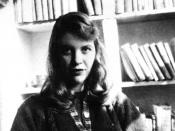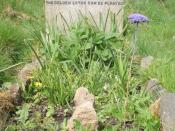One of the running themes in many of Sylvia Plath's poems is that of death, dying, and rebirth. Her fascination with mortality ranges from reluctant acceptance to longing. In this essay I will examine both her view of death and rebirth as well as her view of death as a state of perfection as portrayed in the poems "Lady Lazarus," "Tulips," and "Edge."
Published posthumously, "Lady Lazarus" paints a haunting portrait of a thirty year old woman who desperately longs for death, marking each decade with an attempt at suicide. The most obvious connection in this poem is that of the Bible's Lazarus of Bethany and Plath's title character. In the Bible when Lazarus dies Jesus raises him from the dead in front of a crowd so the non-believers may witness his powers. This parallels Plath's character of Herr Docktor, who resurrects Lady Lazarus in front of onlookers so as to advertise his power.
(Collins, Teresa 1)
Thus, Herr Docktor is identified as Lady Lazarus's enemy. "Dying/Is an art, like everything else./I do it exceptionally well." (Plath, Sylvia 1). By denying her success in her art Herr Docktor forces her to keep trying to commit suicide. (Curley, Maureen 1) But, Plath goes further she makes her title character into a Jew and the Docktor into a Nazi. She brings forth the image of the ovens in the concentration camp; the Docktor can turn her over in the oven until there is nothing left. Afterwards, he will humiliate her further by making soap out of her ashes and melting down her gold fillings and wedding ring, just as the nazi's did in World War II. (Curley, Maureen 2)
Failing at her art and at manipulating the Docktor she vows revenge against her enemies.(Salem Press 1)...



Lovely
I thought this was a really really lovely essay and very well written. There is close analysis of the texts and I thought the poems you picked and the order in which you discussed them complimented the essay very well. Brilliant piece of work and a pleasure to read. well done.
0 out of 0 people found this comment useful.